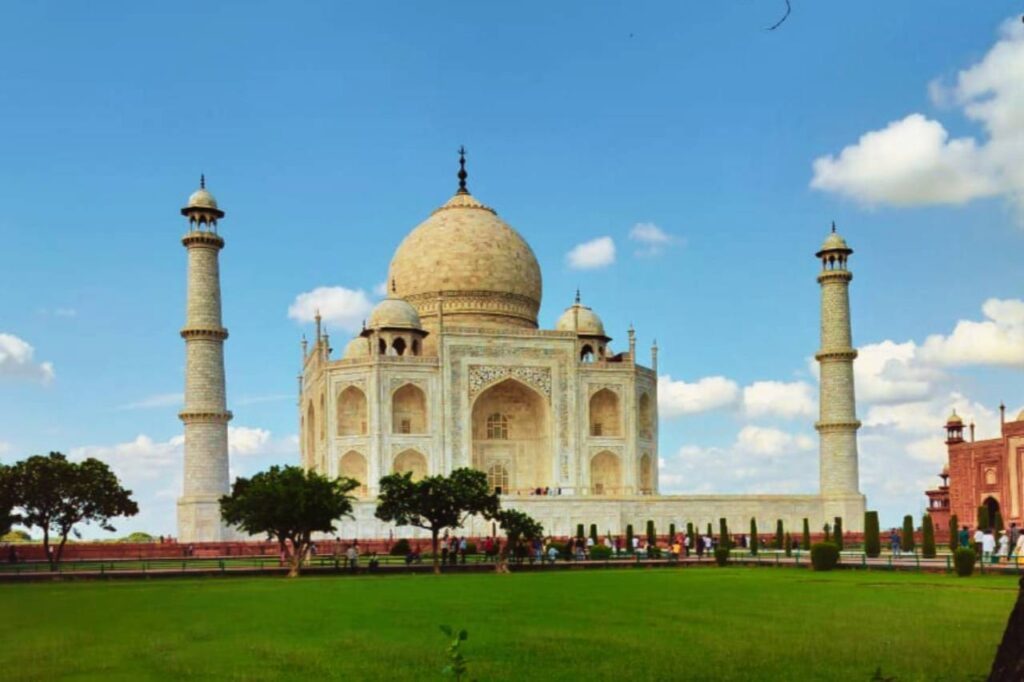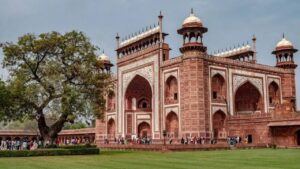Agra, a historic city in northern India, is known for its stunning architecture, especially the iconic Taj Mahal.
- Taj Mahal: The Taj Mahal, an architectural masterpiece in Agra, India, is an iconic symbol of love and a UNESCO World Heritage Site. Commissioned by Emperor Shah Jahan in the 17th century, this white marble mausoleum was built to honor the memory of his beloved wife, Mumtaz Mahal. The Taj Mahal’s exquisite design features intricate carvings, a central dome, four minarets, and a reflecting pool that mirrors its grandeur. Its beauty is particularly mesmerizing during sunrise and sunset when the changing light bathes it in a soft, ethereal glow. The Taj Mahal stands as a timeless testament to the enduring power of love and architectural brilliance.
- Agra Fort: The Agra Fort, another UNESCO World Heritage Site in Agra, India, is a historic fortress that bears witness to centuries of Mughal history. Originally constructed as a military fort in the 16th century, it later served as the primary residence of Mughal emperors, including Akbar, Jahangir, and Shah Jahan. The fort showcases a blend of architectural styles, combining robust red sandstone structures with ornate marble palaces and courtyards. Notable features within the fort include the Jahangir Palace, Khas Mahal, and the iconic Diwan-i-Khas. The Agra Fort’s historical significance and architectural grandeur make it a must-visit site for those exploring Agra’s rich heritage.
- Fatehpur Sikri: Fatehpur Sikri, located just a short distance from Agra, is a UNESCO World Heritage Site that was once the short-lived capital of the Mughal Empire. Built by Emperor Akbar in the late 16th century, this red sandstone city is a masterpiece of Mughal architecture and urban planning. It is famous for its grand Buland Darwaza (Gate of Victory), the stunning Jama Masjid, and the intricately designed Diwan-i-Khas. Fatehpur Sikri’s unique blend of Islamic, Hindu, and Persian architectural elements is a testament to Akbar’s vision of religious tolerance and cultural harmony. The city’s historical and architectural significance draws visitors from around the world.
- Mehtab Bagh: Mehtab Bagh, also known as the “Moonlight Garden,” is a beautiful charbagh complex situated across the Yamuna River from the Taj Mahal in Agra, India. It provides a picturesque and serene viewpoint for the iconic Taj Mahal, making it a popular spot for photography and admiring the monument from a different angle. The garden’s layout is symmetrically designed with quadrilateral paths and lush green lawns, creating a tranquil atmosphere. Mehtab Bagh offers an excellent opportunity to witness the Taj Mahal at different times of the day, with the sunset view being particularly breathtaking, as it bathes the monument in golden hues, making for a stunning visual spectacle.
- Akbar’s Tomb: Akbar’s Tomb, located in Sikandra, a suburb of Agra, is the final resting place of Emperor Akbar, one of the most influential Mughal rulers. This magnificent tomb is an architectural marvel that combines elements of Islamic, Hindu, and Persian styles. The red sandstone structure features a towering five-story minaret-like entrance gate and a large, beautifully designed garden. The tomb’s interior houses Akbar’s cenotaph, adorned with intricate carvings and calligraphy. The fusion of architectural influences and the grandeur of Akbar’s Tomb reflects the emperor’s secular and inclusive approach to governance. It remains an important historical and cultural site in Agra, drawing visitors with its grandeur and historical significance.
- Itimad-ud-Daulah’s Tomb: Itimad-ud-Daulah’s Tomb, often referred to as the “Baby Taj,” is an exquisite Mughal mausoleum located in Agra, India. It was constructed between 1622 and 1628 and is regarded as a precursor to the Taj Mahal in terms of architectural beauty and design. This white marble tomb is dedicated to Mir Ghiyas Beg, a Persian noble who served as the chief minister in the Mughal court and is also the grandfather of Mumtaz Mahal. The tomb features delicate inlay work, intricate marble screens, and lush gardens. Its smaller size compared to the Taj Mahal gives it an intimate and charming atmosphere, making it a hidden gem in Agra’s architectural landscape.
- Jama Masjid: The Jama Masjid in Agra is a magnificent mosque that stands as one of the city’s architectural gems. Built in the 17th century during the reign of Shah Jahan, this grand structure exemplifies Mughal architecture with its towering red sandstone facade, white marble domes, and intricate calligraphy. It boasts a spacious courtyard capable of accommodating thousands of worshippers. The central prayer hall features stunning arches and a richly adorned mihrab (prayer niche). The Jama Masjid’s historical and cultural significance, as well as its architectural beauty, make it a must-visit site for those interested in Agra’s rich Mughal heritage and religious architecture.
- Chini-ka-Rauza: This is a lesser-known but exquisite Mughal monument. It is the tomb of the Persian poet and scholar, Afzal Khan, and is known for its blue-glazed tilework.
- Tomb of Mariam-uz-Zamani: This tomb is dedicated to Mariam-uz-Zamani, who was the wife of Emperor Akbar and the mother of Emperor Jahangir. It’s located in a serene garden setting.
- Guru ka Taal: A historical Sikh pilgrimage site, Guru Ka Taal is a holy pond with a gurdwara (Sikh temple). It’s associated with Guru Tegh Bahadur, the ninth Sikh Guru.



